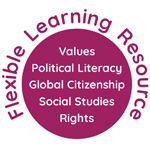Introduction
The lesson helps students understand that while the conflict between Israel and the occupied Palestinian territory has been ongoing for almost 50 years, the situation is not without hope. They learn how, even in the most tragic circumstances, many Israeli, Palestinians and others can work together to bring about understanding and peace.
They also have the opportunity to consider what daily life is like for children on both sides of the conflict and how they have hopes and dreams just like them.
Bring the Banksy image to the attention of learners and ask them what it means to them.
Learning Intention: I am learning about the meaning of reconciliation.
Success Criteria: I can give a definition of reconciliation and give examples from this lesson.
Preparation: Copies of case studies. Room organised for cooperative learning.
“The Parents’ Circle” video ready to play.
Copy of “Parents Circle” questions.
Paper and coloured pens for posters.
Activity 1
Possible answers.
| Palestinian | Israeli | Both |
|
Wish that life could be easier Locked inside when there is a curfew Must leave for school very early in the morning to get through the checkpoints Many families are separated from each other as they can’t cross the checkpoints |
Guards at school Afraid Palestinians will blow them up Have gas masks to protect them Must join the army Believe it would be dangerous to go into Palestinian land |
Want peace Don’t know much about the war but want the fighting to stop Afraid Don’t want to be hurt or hurt others Don’t know people from the other community Have families and friends Want to do well in school Don’t always agree with their parents or siblings Have hopes, dreams and fears |
Activity 2
Parents’ Circle – Possible Answers
1. What had the two men in common ?
A. Both had lost family members in the conflict.
2. What separated them before their bereavements?
A. Each community was fearful and suspicious of the other.
B. Few Israeli civilians ever visit the occupied Palestinian territory.
3. Their losses could have made them hate each other’s communities even more. What helped them overcome this hate?
A. Realised that the pain of loss is the same whether you are Palestinian or Israeli.
B. Learned to listen to each other’s pain.
C. Started to see each other as human beings.
D. Wanted to find another way.
E. Wanted to create some hope out of despair.
4. They talk about their work in Israeli and Palestinian schools. What do you think are the effects on young people when Rami and Mazen visit schools and talk to students?
A. Hear about the pain each man has suffered.
B. Realise there is suffering on both sides.
C. Understand that Palestinians and Israelis can be friends.
D. Hear a message of dialogue, reconciliation and peace instead of hate.
5. How do you think these talks help young Israeli and Palestinian students to influence their communities?
A. Each side has respect for those who have lost loved ones and are therefore more likely to listen to the message.
B. One student who accepts the message can help prevent loss of life.
6. How did Mazen and Rami believe they could help bring about a political solution to the conflict?
A. By building trust with each other and showing that if each side sees each other as human beings and gets to know and to trust each other as individuals they can then tell their leaders that they are ready for them to compromise and sign peace agreements.
B. Develop an understanding that it is not the destiny of Israelis and Palestinians to keep on killing each other, this can stop by talking to each other.
Activity 3
After watching the video of Desmond Tutu’s talk, students discuss what they think might be the first steps towards peace. This would be a good time to remind students of the ground rules they created in the first section of this unit.
Activity 4
Learners consider the cartoon and write a paragraph or create a word cloud or image about their own dreams and wishes for a better world.
